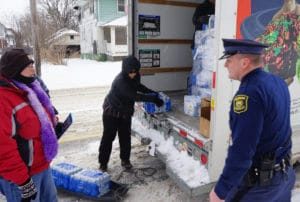 Part three of our four-part series on water crises in America is on lead contamination. Instances of lead in drinking water, such as the situation in Flint, Michigan, have become a hot topic in the media. Lead in drinking water is a problem that reaches far beyond the disaster in Flint, with the Environmental Protection Agency (EPA) stating that roughly 10 million American homes and buildings still receive water from service lines that are at least partially lead. When water has high acidity or low mineral content, it can cause these service lines to corrode and leach lead into the water supply. Without mitigation, water from lead service lines has the potential to cause adverse health effects, particularly in children.
Part three of our four-part series on water crises in America is on lead contamination. Instances of lead in drinking water, such as the situation in Flint, Michigan, have become a hot topic in the media. Lead in drinking water is a problem that reaches far beyond the disaster in Flint, with the Environmental Protection Agency (EPA) stating that roughly 10 million American homes and buildings still receive water from service lines that are at least partially lead. When water has high acidity or low mineral content, it can cause these service lines to corrode and leach lead into the water supply. Without mitigation, water from lead service lines has the potential to cause adverse health effects, particularly in children.
The EPA states that, in the last three years, only nine U.S. states are reporting safe levels of lead in their drinking water. These include Alabama, Arkansas, Hawaii, Kentucky, Mississippi, Nevada, North Dakota, South Dakota, and Tennessee. This means that 41 states are consistently reporting higher than acceptable levels of lead in their drinking water. The problem is not only the lead service lines connecting water mains to homes and buildings, but also the lack of proper treatment to prevent corrosion of these lead pipes.
History of Lead Pipes in the U.S.

The use of lead pipes for water distribution has a centuries-old history. In the U.S., installation of lead pipes on a major scale began in the late 1800s, particularly in the larger cities. At one point, more than 70% of cities with populations greater than 30,000 used lead water lines. Lead pipes had two significant advantages over iron: they lasted almost twice as long and they were malleable enough to easily bend around existing structures. Of course, now we see the health risks associated with lead, and water systems across the country have taken steps to eliminate lead pipes in their distribution systems. Water companies and municipalities now must decide whether to replace all the lead pipe in their drinking water system, including home service lines on private property, or continue to add corrosion-control chemicals at the plant to prevent leaching of lead into the water supply.
Utilities and the Government Take Action
Water companies and municipalities across the country are working diligently to get lead out of our drinking water. Since replacing all of our nation’s lead piping may take over 20 years, utilities have found a short term solution to control the amount of lead in their drinking water. They are focusing on the treatment process and monitoring what makes up the drinking water. Introducing orthophosphates to the water supply and flushing all the standing water creates a scale of protective coating on the interior surfaces of lead pipes, reducing corrosion. This limits the amount of lead that leaches into the water and offers a short term solution as we figure out how to permanently replace all lead pipes from our water distribution systems.

In Wisconsin, the Madison Water Utility has become a national model for cities struggling with lead in their drinking water. They are the first major utility in the nation to demonstrate that a full replacement of both the public and the private portions of lead service lines is possible. This involved working with residents to remove lead service lines from their homes and nearby property. The project started in 2001 and has provided safe drinking water to 5,600 property owners. The plan, which was very controversial at the time, is now hailed as a model and has spurred other utilities into action. For example, Boston Water and Sewer Commission (BWSC) implemented a program that offers a credit of up to $2,000 and interest-free loans to assist homeowners who are willing to remove lead pipes on their property. BWSC also has a searchable online database for homeowners to see if their property has a lead service line. Also, the Massachusetts Water Resource Authority (MWRA) announced earlier this year that it will provide $100 million to its member water communities to fully replace lead service lines, including residential lines. These utilities are shining examples of the many organizations taking a long term approach to this national crisis.
Recent news reports of lead in drinking water and the controversy surrounding testing methodologies have acted as a catalyst for public schools across the country to test their water. Unfortunately, many of these tests indicate high, potentially dangerous, levels of lead concentrations in public drinking fountains, sparking outcry from parents and prompting a series of public meetings. In response, the EPA changed lead testing regulations on February 29, 2016 and now require utilities to use wide mouth bottles, conduct no pre-stagnation flush, and to run faucets at typical flow rates when testing for lead — precisely the opposite of how testing had previously been conducted. While many people have been quick to blame utilities for lead in their drinking water and have even gone so far to suggest that utilities have been practicing testing “cheats,” they were in actuality following protocol issued by EPA.
The EPA is also considering changes to the Safe Drinking Water Act’s rules regarding lead, and an advisory panel has proposed a more proactive approach to replacing lead pipes. The proposal would encourage public water systems to replace lead pipes versus waiting for lead levels to spike to take action. This plan involves substantial increases in funding to water companies and municipalities for the replacement of lead pipes in both the public and the private portions of lead service lines, including residential lines. With this additional funding, water utilities across the country will be able to set goals for a permanent solution to our nation’s lead crisis. Admittedly, we have a long road ahead of us as many cities simply do not know the exact number or location of lead pipes in their system. Add to that the cost and person power required to replace our nation’s lead service lines, and it becomes apparent that a 100% lead-free infrastructure is still many years away.
What Can You Do?
When water sits stagnant in lead service lines for even a few hours, it picks up lead from the pipe, which can make using your faucet hazardous. Find out if your home is serviced by lead service lines by calling your local water department. This is especially important to homes built prior to 1980. If your home still has lead service lines, you can reduce the risk of lead contamination in your drinking water by taking some simple steps:
- Call your State Department of Public Health for health information, or visit their website.
- Run tap water until after the water feels cold. Flushing pipes in this way before use assures that you are not drinking water that has been sitting stagnant in pipes.
- Never use hot water from the faucet for drinking or cooking, especially when making baby formula or food for small children. Hot water from your faucet has a higher chance of containing traces of lead. Instead, use cold water and heat it on the stove or in the microwave.
In Conclusion

The good news is that lead contaminated water crises like the situation in Flint, Michigan have called for stricter regulations and replacement of nearly six million lead service lines nationwide. The not so good news is that we still have a long way to go to completely remove all lead in our water systems. Nearly all homes built prior to the 1980s still have lead solder connecting copper pipes, and some major U.S. cities still have 100 percent lead piping that delivers water from the utilities to homes and businesses. Replacing lead service lines is the safest way to prevent lead contamination, and public and private water companies must work together with state and national organizations to replace lead pipes in all of our water distribution systems. Solving our lead contamination crisis will benefit everyone if we work together for a permanent solution. After all, everyone deserves safe drinking water.




 The truth is, there is too much at stake to keep ignoring our weakening infrastructure. If we do not do something soon, Americans may be in for some serious surprises. Imagine not being able to drink the water that comes out of our faucets or even take a shower without worrying about water borne diseases and bacteria. If we wish to seriously improve our water infrastructure, we need collaboration from all parties, both public and private. Politicians and lawmakers need to take definitive action and commit to a sustainable and reliable plan to make our water systems safe and adequate for the future. We need to make the condition of our country’s water systems a top priority.
The truth is, there is too much at stake to keep ignoring our weakening infrastructure. If we do not do something soon, Americans may be in for some serious surprises. Imagine not being able to drink the water that comes out of our faucets or even take a shower without worrying about water borne diseases and bacteria. If we wish to seriously improve our water infrastructure, we need collaboration from all parties, both public and private. Politicians and lawmakers need to take definitive action and commit to a sustainable and reliable plan to make our water systems safe and adequate for the future. We need to make the condition of our country’s water systems a top priority. Water poverty has long been considered a global crisis, with over 783 million people worldwide — that’s one in nine people — lacking access to a safe, clean water supply. Over half of the world’s hospital beds are filled with people afflicted with water-related illness, and over 80% of illnesses in sub-Saharan Africa are directly attributable to poor water and sanitation conditions. There are a plethora of charities dedicated to solving the global water crisis, including Tata & Howard’s and AWWA’s charity of choice
Water poverty has long been considered a global crisis, with over 783 million people worldwide — that’s one in nine people — lacking access to a safe, clean water supply. Over half of the world’s hospital beds are filled with people afflicted with water-related illness, and over 80% of illnesses in sub-Saharan Africa are directly attributable to poor water and sanitation conditions. There are a plethora of charities dedicated to solving the global water crisis, including Tata & Howard’s and AWWA’s charity of choice 



 The answer to solving the water crisis of Navajo Nation is not simple. Bringing safe, clean water to the people of Navajo Nation will require both public and private investment. It will also require fair legislation that allows the Navajo to keep rights to water on their land while requiring the federal government to fund the
The answer to solving the water crisis of Navajo Nation is not simple. Bringing safe, clean water to the people of Navajo Nation will require both public and private investment. It will also require fair legislation that allows the Navajo to keep rights to water on their land while requiring the federal government to fund the 












